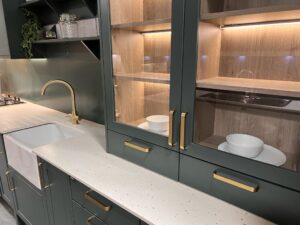When renovating a kitchen or building a new home, choosing the right countertop can significantly impact the aesthetics, functionality, and durability of your kitchen. There are several popular materials available, each with its unique advantages and disadvantages. This guide will help you navigate through these options to find the most durable countertop for your home.
Granite Countertops
Pros:
- Durability: Granite is known for its toughness and resistance to scratches, heat, and stains when sealed properly.
- Appearance: Each slab is unique, offering various colors and natural patterns.
Cons:
- Cost: It can be expensive, depending on the type and thickness.
- Maintenance: Requires periodic sealing to prevent stains.
Quartz Countertops
Pros:
- Durability: Quartz is extremely hard and durable, not requiring sealing.
- Variety: Available in many colors and patterns, engineered to mimic natural stone.
Cons:
- Sensitivity to Heat: Can be damaged by excessive heat; trivets and hot pads are necessary.
- Cost: Generally more expensive than granite.
Marble Countertops
Pros:
- Aesthetics: Known for its high-end, classic look that adds value to your home.
- Cool Temperature: Stays naturally cool, making it ideal for baking.
Cons:
- Porosity: Prone to staining and scratching, requires regular sealing.
- Cost: Can be very expensive.
Laminate Countertops
Pros:
- Affordability: Less expensive than stone options.
- Ease of Maintenance: Easy to clean and doesn’t require sealing.
Cons:
- Durability: Not as heat or scratch-resistant as stone; can be damaged relatively easily.
- Resale Value: Does not improve home resale value as much as stone.
Solid Surface Countertops
Pros:
- Seamless Design: Offers a smooth surface without seams.
- Repairable: Scratches and burns can be sanded out.
Cons:
- Heat Resistance: Vulnerable to heat and can be damaged by hot pots and pans.
- Cost: Can be as expensive as some natural stone options.
Butcher Block (Wood) Countertops
Pros:
- Warmth and Beauty: Adds a warm, inviting look to the kitchen.
- Practical for Cutting: Can serve as a large cutting board.
Cons:
- Maintenance: Requires oiling to prevent drying and cracking.
- Susceptibility to Damage: Can be scratched and stained if not maintained properly.
Soapstone Countertops
Pros:
- Durability: Quite durable and resistant to staining.
- Aesthetic: Offers a rich, deep color that develops a sought-after patina over time.
Cons:
- Scratchability: It is susceptible to scratches; however, these can often be sanded out.
- Limited Color Range: Typically found in shades of gray.
Stainless Steel Countertops
Pros:
- Hygiene: Non-porous surface is hygienic and easy to sterilize.
- Heat Resistance: Highly heat-resistant and durable.
Cons:
- Scratches and Dents: Prone to scratches and dents.
- Noise: Can be noisy during use.
Concrete Countertops
Pros:
- Customizable: Can be shaped and tinted to suit any decor.
- Durability: Extremely durable when sealed correctly.
Cons:
- Maintenance: Requires regular sealing.
- Weight: Very heavy, requiring reinforced cabinetry.
Conclusion: Choosing the Most Durable Countertop
When prioritizing durability, quartz and granite are typically the top choices due to their resistance to heat, scratches, and stains. Quartz offers a slightly higher level of ease in maintenance since it doesn’t require sealing, whereas granite provides a unique aesthetic with each slab. For those looking for the utmost in durability and willing to handle the maintenance, quartz is often the most durable and practical choice for busy kitchens.
